- Photo Safaris
- Alaska Bears & Puffins World's best Alaskan Coastal Brown Bear photo experience. Small group size, idyllic location, deluxe lodging, and Puffins!
- Participant Guestbook & Testimonials Candid Feedback from our participants over the years from our photo safaris, tours and workshops. We don't think there is any better way to evaluate a possible trip or workshop than to find out what others thought.
- Custom Photo Tours, Safaris and Personal Instruction Over the years we've found that many of our clients & friends want to participate in one of our trips but the dates we've scheduled just don't work for them or they'd like a customized trip for their family or friends.
- Myanmar (Burma) Photo Tour Myanmar (Burma) Photo Tour December 2017 -- with Angkor Wat option
- Reviews Go hands-on
- Camera Reviews Hands-on with our favorite cameras
- Lens reviews Lenses tested
- Photo Accessories Reviews Reviews of useful Photo and Camera Accessories of interest to our readers
- Useful Tools & Gadgets Handy tools and gadgets we've found useful or essential in our work and want to share with you.
- What's In My Camera Bag The gear David Cardinal shoots with in the field and recommends, including bags and tools, and why
- Articles About photography
- Getting Started Some photography basics
- Travel photography lesson 1: Learning your camera Top skills you should learn before heading off on a trip
- Choosing a Colorspace Picking the right colorspace is essential for a proper workflow. We walk you through your options.
- Understanding Dynamic Range Understanding Dynamic Range
- Landscape Photography Tips from Yosemite Landscape Photography, It's All About Contrast
- Introduction to Shooting Raw Introduction to Raw Files and Raw Conversion by Dave Ryan
- Using Curves by Mike Russell Using Curves
- Copyright Registration Made Easy Copyright Registration Made Easy
- Guide to Image Resizing A Photographers' Guide to Image Resizing
- CCD Cleaning by Moose Peterson CCD Cleaning by Moose Peterson
- Profiling Your Printer Profiling Your Printer
- White Balance by Moose Peterson White Balance -- Are You RGB Savvy by Moose Peterson
- Photo Tips and Techniques Quick tips and pro tricks and techniques to rapidly improve your photography
- News Photo industry and related news and reviews from around the Internet, including from dpreview and CNET
- Getting Started Some photography basics
- Resources On the web
- My Camera Bag--What I Shoot With and Why The photo gear, travel equipment, clothing, bags and accessories that I shoot with and use and why.
- Datacolor Experts Blog Color gurus, including our own David Cardinal
- Amazon Affiliate Purchases made through this link help support our site and cost you absolutely nothing. Give it a try!
- Forums User to user
- Think Tank Photo Bags Intelligently designed photo bags that I love & rely on!
- Rent Lenses & Cameras Borrowlenses does a great job of providing timely services at a great price.
- Travel Insurance With the high cost of trips and possibility of medical issues abroad trip insurance is a must for peace of mind for overseas trips in particular.
- Moose Peterson's Site There isn't much that Moose doesn't know about nature and wildlife photography. You can't learn from anyone better.
- Journeys Unforgettable Africa Journeys Unforgettable -- Awesome African safari organizers. Let them know we sent you!
- Agoda International discounted hotel booking through Agoda
- Cardinal Photo Products on Zazzle A fun selection of great gift products made from a few of our favorite images.
- David Tobie's Gallery Innovative & creative art from the guy who knows more about color than nearly anyone else
- Galleries Our favorite images
Sony a6300 compact mirrorless field tested: Amazing tech in a small package
Sony a6300 compact mirrorless field tested: Amazing tech in a small package
Submitted by David Cardinal on Wed, 04/13/2016 - 08:03
 I've spent a lot more time shooting with the new Sony a6300 since my first look article, and the experience has reinforced my impressions -- both pro and con. On the pro side, the speed and image quality is really amazing. I covered multiple events at Nvidia's tech conference, in a variety of awful lighting conditions, and the camera performed flawlessly at ISOs up to 3200 (where I had Auto ISO set to top out). However, even after some customization of the interface, I found the controls inefficient, especially in dark rooms.
I've spent a lot more time shooting with the new Sony a6300 since my first look article, and the experience has reinforced my impressions -- both pro and con. On the pro side, the speed and image quality is really amazing. I covered multiple events at Nvidia's tech conference, in a variety of awful lighting conditions, and the camera performed flawlessly at ISOs up to 3200 (where I had Auto ISO set to top out). However, even after some customization of the interface, I found the controls inefficient, especially in dark rooms.
Impressive image quality
The Sony a6300 features a new 24MP sensor, that produces great images -- although at high ISOs I had to tweak the noise reduction settings in Adobe Camera Raw / Lightroom to get the best results. I look forward to trying DxO's PRIME noise reduction once Optics Pro adds support for the camera. Raw images are captured in 15-bit precision (this is not the same as dynamic range!), which is nice for potentially preventing artifacts in large, evenly-toned, areas.
One welcome feature for videographers is support for 4K video -- in either 24 or 30 fps, at up to 100 Mbps, or even raw uncompressed if you have your own HDMI-based recorder. Video is produced with the sensor running at full resolution and then downsampling, which Sony says results in better quality than native 4K. 1080p is supported up to 120 fps.
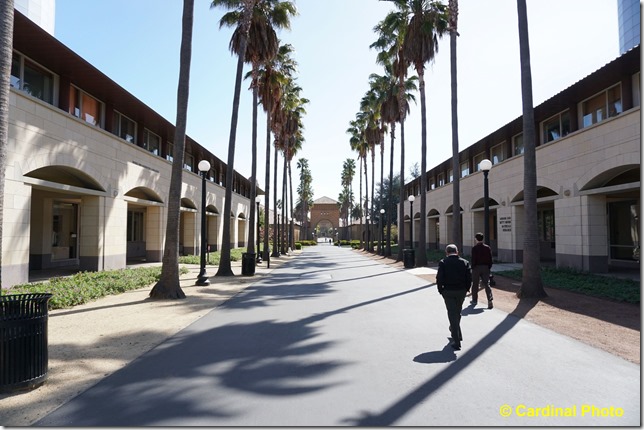
I shot this high contrast scene at +1 to open up the shadows,
but the Sony a6300 still did a great job of keeping a reasonable amount of color in the sky.
Freaky fast
This is probably the first "small" camera I've used where the continuous shooting mode was so quick that I had to re-train my finger to avoid accidentally firing off multiple frames. It's 11+ fps is fast enough for just about any application. An 8 fps mode is available that reduces the percentage of time the viewfinder is blacked out. For those who think high framerates are only good for sports and wildlife, it is amazing how much difference there can be in facial expressions in just 1/10th of a second. So, if you can deal with the extra work of looking through multiple versions of the same photo, give high-speed continuous a try! There is a reason you hear the machine-gun-like sound of lots of fast cameras at the beginning and end of every press conference. Getting exactly the right pose and expression matters!
Focus is just as quick, and the combination of hundreds of focus points (425 phase detect and 169 contrast detect) along with a fast processor means that the intelligent AF is also very good. I often left the camera set to its intelligent focus mode, with the focus points it was using highlighted in the scene. That allowed me to easily see if I was getting locked onto the right subject. That works well for rapid action, especially in low-light conditions where it can be hard to see what is in focus with just your eyes. For those times when you're hoping to compose and focus carefully, then turning the intelligent mode off and focusing yourself is of course a more traditional and potentially more accurate way to go.
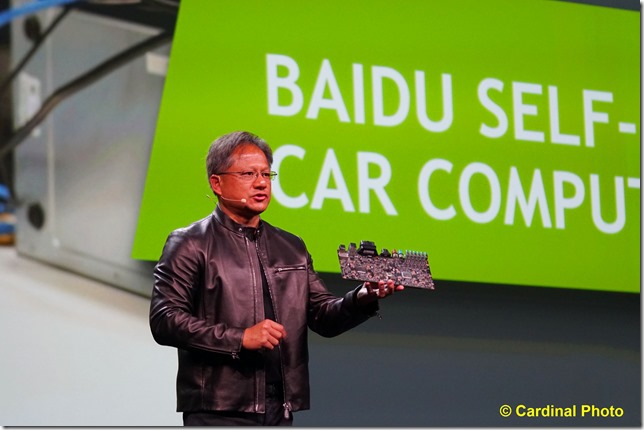
High frame rates aren’t just for sports. Covering events also rewards getting just the right expression.
Sony a6300, Sony 70-200mm f/4 lens, f/4 @ 1/160s, ISO 2500
Because of the way AF is setup, you can (at least on paper) get full AF functionality when using an adapter to mount Sony's A-mount lenses, or even with a Metabones adapter for Canon's EF lenses -- but I didn't test this myself.
Amateur controls on a pro-quality camera
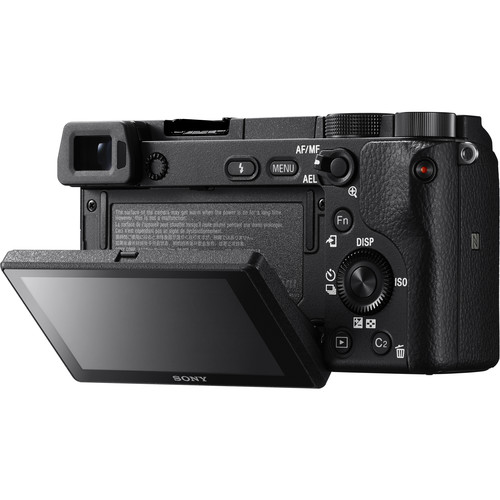 There is a saying that the best camera is the one you have with you. For most pros, the very best camera is the one they can operate almost without thinking, and certainly without looking. Your fingers should know how to be operating the controls without you needing to peer at the camera, (or for touchscreen-equipped cameras, fiddle with the screen). This is especially true if you are paid to photograph events, sports, wildlife, or anything dynamic -- especially in low light conditions. One mantra all my workshop participants have heard is "If you can't do it in the dark, you're not doing it enough."
There is a saying that the best camera is the one you have with you. For most pros, the very best camera is the one they can operate almost without thinking, and certainly without looking. Your fingers should know how to be operating the controls without you needing to peer at the camera, (or for touchscreen-equipped cameras, fiddle with the screen). This is especially true if you are paid to photograph events, sports, wildlife, or anything dynamic -- especially in low light conditions. One mantra all my workshop participants have heard is "If you can't do it in the dark, you're not doing it enough."
Nikon and Canon realize this (and personally I think Nikon does a better job with it, but it’s the system I'm most familiar with, so I'm biased). You can change just about every setting on a pro DSLR from those vendors with your eyes closed (sure, you might not be able to check exactly how far you adjusted something, but if you know what you have your e.v. steps and ISO steps set to, you can change aperture, shutter speed, ISO, and exposure compensation quickly and effectively in almost any situation. (Except when Nikon periodically switches the order of the buttons on the back, which drives me nuts since I have to remember which model camera I'm using or look at the button).
By contrast, the Sony a6300, while offering essentially all of the same flexibility, it is trapped behind a variety of small, somewhat-tricky, and not-always-well-placed controls. In fairness to the camera, once you customize the control locations a bit, and get used to their layout, they are definitely workable. But definitely not optimal. For anyone used to DSLR controls, they'll take some getting used to. Some of the annoyances I found:
- The record button is way off to the right, so you need to practically pull your hand off the camera to push it. You can remap buttons, but it'd be nice if it was handy in the first place.
- Similarly, the back control wheel (that you can use like a Nikon or Canon command dial) is too close to the side of the camera, so it isn't naturally where your thumb can find it. I _think_ this is because Sony wanted to move the mode dial away from the edge of the camera so it wouldn't get moved accidentally. A better solution would have been a lock on the mode dial (like the one Nikon added to the D7100 to address this issue with the D7000).
- Instead of buttons for common functions, the camera uses a point-and-shoot style rocker and small, ridged, surrounding ring -- augmented with a couple buttons. With some practice, this is usable, but not nearly as simple to operate as the "push a button & then turn the command dial" interface on most DSLRs.
- The rocker & ring setup is modal -- meaning that once you press the rocker in a particular direction, you can turn the ring to change that value, or you can press the other sides of the rocker. However, that means you have to remember to press the center button of the rocker to get out of this mode, and allow the other sides of the rocker to go back to their regular function. It makes the system pretty error prone if you aren't looking.
- Not surprisingly, there isn't a top LCD. That's typical of cameras this small, but is a really handy feature on most DSLRs. Fortunately, most of the necessary information is also in the EVF, so you don't have to look at the LCD every time you want to know how your camera is set.
- While not a control issue, per se, the SD card slot is placed very close to the battery cover hinge. That makes it a little tricky to pull out. Fortunately, with the availability of super-large cards like the new 200GB UHS-1 (95MB/second) microSD card from Lexar, you won’t need to swap cards in the field very often. (When traveling with my SD card slot equipped laptop, I typically use full-size SD cards, but when traveling with only a tablet like the Surface Pro 4 or Lenovo Miix 700, I can use a microSD card with adapter and then transfer images easily using its microSD slot). This tiny card holds over 5700 Raw+JPEG files from the a6300!
Super-sweet EVF, lens-based stabilization
 The Electronic Viewfinder (EVF) is really nice. It shows up quickly when you put your eye to the camera, and is very high quality. It is always available, unlike on some of the smaller Sony's, where it is a pop-up.
The Electronic Viewfinder (EVF) is really nice. It shows up quickly when you put your eye to the camera, and is very high quality. It is always available, unlike on some of the smaller Sony's, where it is a pop-up.
Similar to Canon and Nikon DSLRs, stabilization is not in the camera body, but needs to be a feature of the lens. The a6300 does have a hot shoe, and works with a variety of flashes, including the very-convenient Sony HVL-F20M Flash unit.

One advantage of the relatively-large (for a small camera) sensor is a better ability to isolate subjects.
Sony a6300, Sony 16-50mm lens, f/4 @ 1/160s, ISO 100, iAuto mode
Chock full of features
The Sony a6300 also has the full raft of features we've come to expect from Sony. Lots of Scene modes, WiFi with NFC pairing, an excellent Panorama mode, downloadable apps, custom settings banks, and an articulating LCD. Most of these aren't that helpful if you're used to shooting Raw and controlling your camera yourself, but for quick shots or for those who want the camera to do more of the work, they offer plenty of options. One interesting feature is an Eye detection mode that builds on face detect to actually look for a subject's eyes to be open and facing the camera before shooting.
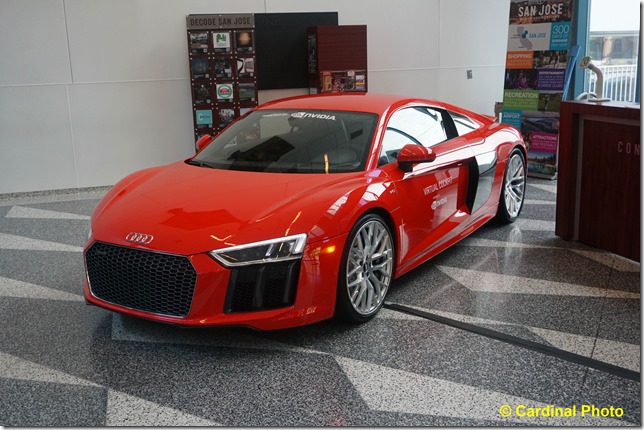
The Sony a6300 has no trouble capturing color, even saturated, metallic reds like on this show car
Thoughts on the Sony 16-50mm "kit" lens and the Sony 70-200mm f/4 lens
 I tried two lenses with the camera. The Sony 16-50 (E-mount) "kit" lens is fine, but I found the motorized zoom a completely un-necessary, and slightly annoying feature. I would have much rather only had the standard zoom ring. The Sony 70-200mm f/4 lens (full-frame E-mount) was excellent. It is not small -- about the same size as a Nikon or Canon equivalent -- but it handles well, focuses quickly, and captures great images. On the APS-C format sensor in the Sony a6300, you get an effective 105mm - 300mm range, which is enough for most applications. It also features a removable lens collar, dual-mode stabilization, and a range limit switch, so it has everything you need for pro shooting with it.
I tried two lenses with the camera. The Sony 16-50 (E-mount) "kit" lens is fine, but I found the motorized zoom a completely un-necessary, and slightly annoying feature. I would have much rather only had the standard zoom ring. The Sony 70-200mm f/4 lens (full-frame E-mount) was excellent. It is not small -- about the same size as a Nikon or Canon equivalent -- but it handles well, focuses quickly, and captures great images. On the APS-C format sensor in the Sony a6300, you get an effective 105mm - 300mm range, which is enough for most applications. It also features a removable lens collar, dual-mode stabilization, and a range limit switch, so it has everything you need for pro shooting with it.
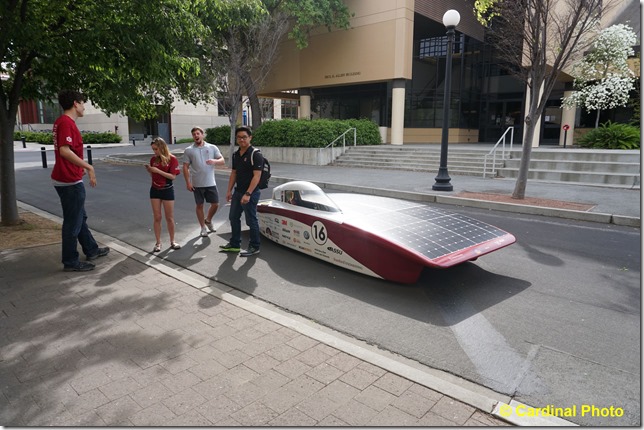
The a6300 takes a couple seconds to power on, but if you remember to switch it on as you pull it up to shoot,
you can get some excellent grab shots like this one of Stanford’s solar car about to start a practice run.
Get the best deals and best service at B&H: |
  |
Is the Sony a6300 right for you?
 The Sony a6300 is a solid upgrade from the a6000, so if you've been waiting for a chance to up your game, and have the $1000 to spare, you'll enjoy the new model. However, it isn't a massive update, so there isn't any reason to feel you have to make the switch. Similarly, if you are looking to downsize from a DSLR, this is a very cool camera -- if you're okay with the controls. Note, though, that the lenses for this camera aren't any smaller than the lenses for an APS-C-format sensor DSLR, so if you travel with a lot of lenses, the slightly smaller body may not save you much. If you're just getting started in the Sony system, the Sony a6300 plus kit lens is $1150 at B&H. Or you can browse Sony’s full line of mirrorless cameras.
The Sony a6300 is a solid upgrade from the a6000, so if you've been waiting for a chance to up your game, and have the $1000 to spare, you'll enjoy the new model. However, it isn't a massive update, so there isn't any reason to feel you have to make the switch. Similarly, if you are looking to downsize from a DSLR, this is a very cool camera -- if you're okay with the controls. Note, though, that the lenses for this camera aren't any smaller than the lenses for an APS-C-format sensor DSLR, so if you travel with a lot of lenses, the slightly smaller body may not save you much. If you're just getting started in the Sony system, the Sony a6300 plus kit lens is $1150 at B&H. Or you can browse Sony’s full line of mirrorless cameras.
- Log in to post comments

